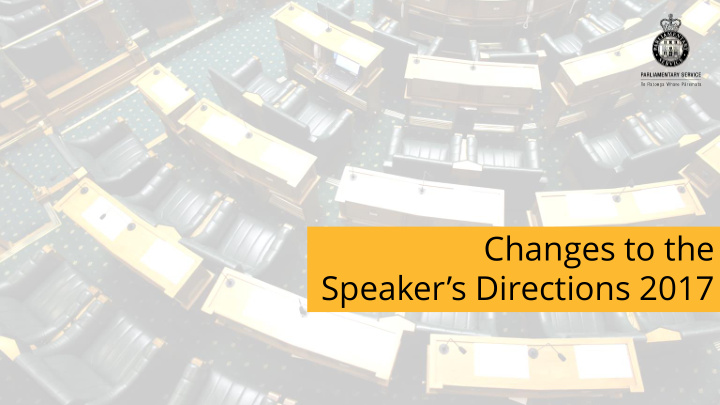



Changes to the Speaker’s Directions 2017
HOW DID WE GET HERE? Funding for all Appropriations Review The Parliamentary The Parliamentary The PSC agreed to the recommendations was Committee (ARC) met Service Commission prioritised list and Service prepared the bid secured in Budget 2017. MPs at the start of the to secure the funds. (PSC) determined the requested a number of 51 st Parliament and recommendations they changes to members consulted on funding wished to consider and funding. pressures members face. formed a Speaker’s From this, a series of Directions working party recommendations were to report back with a made. prioritised list.
FUNDING ALLOCATIONS KEY POINTS - MEMBERS There is a new model for individual member non-staff allocations. • Most electorate members’ offices are in retail spaces, ranging in size between 90 – 105m 2 , and operating costs consume half their funding. • On the basis that most constituency members spend half their funding on rent, an allocation of $70,000 allows $35,000 for office costs and $35,000 for other costs. • Differentials (from normal constituency) for list members (64%) and large constituency members (133%) will remain the same. • Members retain the flexibility (with the general sub-allocation) to tailor expenditure to suit their particular style of constituent engagement and management.
FUNDING ALLOCATIONS KEY POINTS – MEMBERS non-staff allocation cont. 52 nd Parliament $p.a MP Type Current $p.a List 40,932 44,800 Constituency 64,260 70,000 Large Constituency 85,500 93,100
FUNDING ALLOCATIONS KEY POINT – PARTIES • Each party’s fixed funding will increase by $15,000 to reflect that there have been no funding increases since 2008. For future terms, further increases will be based on CPI changes. 52 nd Parliament $p.a Allocation Current $p.a Each party 100,000 116,900 Non Exec member 64,320 65,400 Caucus member 22,000 22,400
LARGE CONSTITUENCY KEY FEATURES: • Large Constituencies qualify for 33% additional staff, non-staff and ICT funding allocations. • Northland and Wairarapa are now classified as large constituencies.
STAFF KEY FEATURES • Extra Duties Allocation for the Speaker, Assistant Speaker, Deputy Speaker, party leaders and whips only. The Extra Duties Allocation for Select Committee Chairs has been removed. • Increase to four weeks’ relief funding per FTE (up from three). Relief weeks (52 nd ) MP type Staff (FTE) Relief weeks (current) Executive List 1 3 4 Non-Executive List / Executive 2 6 8 Constituency Non-Executive Constituency / 3 9 12 Executive Large Constituency Non-Executive Large Constituency 4 12 16
STAFF KEY FEATURES • Funding to recruit one staff member at a senior level which enables MPs to recruit/retain staff with the necessary skills. • Three new hybrid roles available in the job families framework = greater flexibility. Roles available: Administrative Assistant Parliamentary Member Support and Communications * • • Parliamentary Executive Assistant Parliamentary Community Engagement and Communications * • • Parliamentary Executive Support and Researcher Parliamentary Communications and Social Media * • • Parliamentary Member Support Parliamentary Communications, Research and Policy Assistant • • Parliamentary Senior Member Support Parliamentary Communications, Research and Policy Advisor • • * New role
ICT KEY FEATURES • The ICT funding allocation will enable members to equip support staff with a smart- phone and laptop, per FTE, based on the current FTE model. • Funding is for equipment able to run recommended business applications, and includes the connection plan. MP type ICT for staff Executive List 1x smart-phone, 1x laptop (within budget) Non-Executive List / Executive Constituency 2x smart-phones, 2x laptops (within budget) Non-Executive Constituency / Executive Large Constituency 3x smart-phones, 3x laptops (within budget) Non-Executive Large Constituency 4x smart-phones, 4x laptops (within budget)
OUT OF PARLIAMENT OFFICES KEY FEATURES In addition to funding provided to members in their non-staff support allocation, the Service will be funded to provide: • Security measures and office furniture to: • Address unacceptable risk levels for members, staff and visitors in these offices, and • Help to meet members’ and the Service’s responsibilities under the Health and Safety at Work Act 2015. • Ergonomic furniture for each out-of-Parliament FTE for their main place of work. The Speaker has also approved the introduction of minimum security specifications.
FURTHER INFORMATION The policies listed below are available on the intranet and provide further, detailed information on how the Speaker’s Directions apply: • Members’ Engaging and Managing Support Staff Policy • Members’ Out of Parliament Office Policy • Members’ ICT Policy • Members’ Travel Policy • Members’ Legal Costs Policy • Members’ Publicity Policy • Members Planning, Budgeting and Certifying Expenditure Policy • Members’ Hospitality and Other Minor Expenditure Policy • Members Access to Additional Support Policy
QUESTIONS? For questions, or advice, on the Speaker’s Directions please contact the Policy and Directions Advice team or your Members’ Case Manager.
Recommend
More recommend